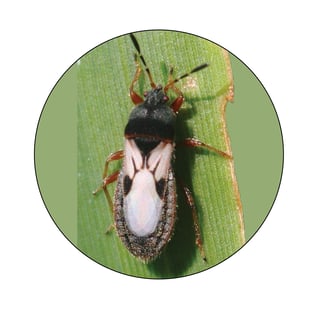A Closer Look with Ian Rodriguez
- Southern chinch bugs (Blissus insularis) are often the biggest pest concern for lawns in the Southeast, particularly in Gulf Coast states where St. Augustine grass is the prominent turf. Unlike webworms, which typically cause temporary damage, chinch bugs will likely result in permanent turf loss if not addressed. In recent years, the hairy chinch bug (Blissus leucopterus hirtus) has been a pest of growing concern further northward on perennial rye, bentgrass, and Kentucky bluegrass. In both cases, permanent loss of patches of turf quickly leads to patches of weeds since the turf is not providing any competition.
- In terms of turf pests, chinch bugs are in the minority since they feed directly on internal fluids of grasses with their piercing-sucking mouthparts rather than chewing like grubs, caterpillars, weevils, and mole crickets. This can make early stages of damage difficult to notice, but over time, their feeding has a phytotoxic effect on the turf, resulting in an orange-yellow leaf discoloration, which eventually turns brown as the turf dies. In St. Augustinegrass, some may confuse this discoloration with brown patch or take-all root rot, which tend to cause a brighter-yellow discoloration, but closer observation usually reveals plenty of live chinch bugs by the time the symptoms occur. Peeling back a yellowing leaf sheath often reveals a tiny orange nymph feeding inside when pressure is high.
- Chinch bug damage often turns up first in hotter or drought-stressed areas of the turf. Therefore, it is very common to see damage along driveways, sidewalks, and streets as they radiate heat all day into the surrounding areas. The hotter the conditions, the faster chinch bugs can develop, with up to 10 generations per year possible in southern Florida. “Hot spots” developing from malfunctioning or poorly-adjusted irrigation systems can turn into chinch bug headaches no matter where they occur in a lawn.

- A convenient method for professionals to check for chinch bugs is the use of a leaf blower converted to vacuum mode with a fine mesh over the end of the tube. Whether vacuuming or simply getting down close for a visual inspection, the heaviest numbers are often just beyond the discolored turf in adjacent green turf since there is typically not much left to feed on in the brown areas. This is important to keep in mind if attempting to spot-treat an area also, as treating a “halo” of at least 10 feet beyond the visual symptoms will likely yield better results.
- The healthier the turf is, the more pest pressure it can tolerate, so proper mowing and moisture management can play big roles in avoiding or limiting severe damage. It is fairly common to see St. Augustine grass mown too closely, which weakens the turf over time and makes it more susceptible to pests and environmental stress. It has long been established as a best management practice that mower clippings should not be bagged. Use of mulching mowers/blades returns clippings to the turf does not cause thatch buildup since they decompose rapidly, releasing nutrients back to the soil and reducing fertilizer needs. Overfertilization has been associated with chinch bugs, likely due to higher nitrogen contents and excessive thatch accumulation from high growth rates. Excessive growth from overwatering may also contribute to thatch buildup, favoring chinch bugs.
Subscribe to our website and follow Quali-Pro on Facebook & Twitter for promotions, product launches, product info and much more!
